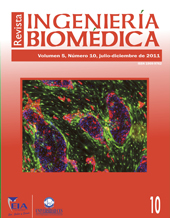MODELADO Y SIMULACIÓN DE UN ROBOT PARA CIRUGÍA ENDOSCÓPICA TRANSLUMINAL - Modeling and simulation of a robot for endoscopic translumenal surgery
MODELADO Y SIMULACIÓN DE UN ROBOT PARA CIRUGÍA ENDOSCÓPICA TRANSLUMINAL - Modeling and simulation of a robot for endoscopic translumenal surgery
Barra lateral del artículo
Cómo citar
Mosquera Leyton, V. H., Vivas Albán, O. A., & Rengifo Rodas, C. F. (2012). MODELADO Y SIMULACIÓN DE UN ROBOT PARA CIRUGÍA ENDOSCÓPICA TRANSLUMINAL - Modeling and simulation of a robot for endoscopic translumenal surgery. Revista Ingeniería Biomédica, 5(10), 44–50. https://doi.org/10.24050/19099762.n10.2011.97
Publicado:
May 3, 2012
Palabras clave:
Número
Sección
Artículo original
Licencia
![]()
Esta obra está bajo una Licencia Creative Commons Atribución-NoComercial-NoDerivativa 4.0 Internacional
Contenido principal del artículo
Víctor Hugo Mosquera Leyton
Facultad de Ingeniería Electrónica y Telecomunicaciones, Universidad del Cauca, Popayán, Colombia
Oscar Andrés Vivas Albán
Facultad de Ingeniería Electrónica y Telecomunicaciones, Universidad del Cauca, Popayán, Colombia
Carlos Felipe Rengifo Rodas
Facultad de Ingeniería Electrónica y Telecomunicaciones, Universidad del Cauca, Popayán, Colombia
Resumen
Este artículo presenta el diseño de un nuevo robot para cirugía endoscópica transluminal. Este tipo de cirugía, evolución tecnológica de la cirugía laparoscópica, pretende ingresar al abdomen del paciente por los orificios naturales (boca, uretra, ano o vagina), y desde allí acceder al sitio donde se hace necesaria la intervención, procedimiento que conlleva muchas más ventajas respecto a la cirugía laparoscópica. El robot diseñado consta de diecinueve grados de libertad y es movido por un joystick utilizando un controlador por par calculado. La simulación muestra bajos errores cartesianos y movimientos muy precisos del órgano terminal.
Abstract— This article presents the design of a new robot for translumenal endoscopic surgery. This type of surgery, evolved from laparoscopic surgery, allows the access into the abdominal cavity of the patient through natural orifices such as the mouth, urethra, anus or vagina, and from there reaches the area of the surgical intervention. This procedure has many advantages over laparoscopic surgery. The designed robot has nineteen degrees of freedom and is moved with a joystick device and controlled by a computer torque control. Simulation shows low cartesian errors as well as accurate movements at the end effector.
Abstract— This article presents the design of a new robot for translumenal endoscopic surgery. This type of surgery, evolved from laparoscopic surgery, allows the access into the abdominal cavity of the patient through natural orifices such as the mouth, urethra, anus or vagina, and from there reaches the area of the surgical intervention. This procedure has many advantages over laparoscopic surgery. The designed robot has nineteen degrees of freedom and is moved with a joystick device and controlled by a computer torque control. Simulation shows low cartesian errors as well as accurate movements at the end effector.
Descargas
Los datos de descargas todavía no están disponibles.


 http://hdl.handle.net/11190/505
http://hdl.handle.net/11190/505
 FLIP
FLIP







